1, nginx compilation and installation
1. Download installation package, compile and install
yum install -y wget gcc gcc-c++ make pcre pcre-devel zlib zlib-devel openssl openssl-devel cd /usr/local/src yum install lrzsz -y wget 'http://nginx.org/download/nginx-1.14.2.tar.gz' tar -zxvf nginx-1.14.2.tar.gz cd nginx-1.14.2 ./configure --prefix=/usr/local/nginx make && make install
2. Check configuration file, start, reload, stop nginx command
/usr/local/nginx/sbin/nginx -t /usr/local/nginx/sbin/nginx /usr/local/nginx/sbin/nginx -s reload /usr/local/nginx/sbin/nginx -s stop
3. Use systemctl to manage Nginx, VIM / usr / lib / SYSTEMd / system / Nginx service
For systemctl details, please refer to http://www.siguoya.name/pc/home/article/46
[Unit] Description=nginx After=network.target [Service] Type=forking ExecStart=/usr/local/nginx/sbin/nginx [Install] WantedBy=multi-user.target
systemctl Start, reload, stop, start and self start nginx command
systemctl start nginx systemctl restart nginx systemctl stop nginx systemctl enable nginx.service
2, PHP compilation and installation
1. Download the installation package, compile and install
yum -y install epel-release yum -y install gcc gcc-c++ make pcre pcre-devel zlib zlib-devel openssl openssl-devel libxml2 libxml2-devel libcurl libcurl-devel libjpeg libjpeg-devel libpng libpng-devel freetype freetype-devel openldap openldap-devel libmcrypt libmcrypt-devel cd /usr/local/src/ wget 'http://hk1.php.net/distributions/php-5.6.40.tar.gz' tar -zxf php-5.6.40.tar.gz cd php-5.6.40 ./configure --prefix=/usr/local/php --with-config-file-path=/usr/local/php/etc --enable-ctype --with-mysql=mysqlnd --with-mysqli=mysqlnd --with-freetype-dir --with-jpeg-dir --with-png-dir --with-zlib --with-libxml-dir=/usr --enable-xml --disable-rpath --enable-bcmath --enable-shmop --enable-sysvsem --enable-inline-optimization --with-curl --enable-mbregex --enable-mbstring --with-mcrypt --with-gd --enable-gd-native-ttf --with-openssl --with-mhash --enable-pcntl --enable-sockets --with-ldap-sasl --with-xmlrpc --enable-zip --enable-soap --with-gettext --enable-fpm make && make install cp php.ini-production /usr/local/php/etc/php.ini
php compilation and installation instructions
--prefix appoint php Installation directory of --with-config-file-path appoint php Configuration file location for --with-mysql,--with-mysqli Give Way php Can operate mysql --enable-fpm Mainly nginx To call php Use of language php-fpm
2. Use default profile
mv /usr/local/php/etc/php-fpm.conf.default /usr/local/php/etc/php-fpm.conf
3. Add environment variable
echo "export PATH=$PATH:/usr/local/php/sbin/:/usr/local/php/bin/" >> /etc/profile source /etc/profile
4. Check the configuration file and start the php command:
/usr/local/php/sbin/php-fpm -t /usr/local/php/sbin/php-fpm

5. Use systemctl to manage PHP FPM, VIM / usr / lib / SYSTEMd / system / PHP FPM service
[Unit] Description=php-fpm After=network.target [Service] Type=forking ExecStart=/usr/local/php/sbin/php-fpm ExecStop=/bin/pkill -9 php-fpm [Install] WantedBy=multi-user.target
systemctl start, reload, stop, start and start php commands
systemctl start php-fpm.service systemctl restart php-fpm.service systemctl stop php-fpm.service systemctl enable php-fpm.service
6. The default configuration of nginx cannot handle the PHP program / usr / local / nginx / HTML / test php
<?php echo "zabbix"; ?>
Configuration of nginx + PHP FPM combination
location / {
root html;
index index.html index.htm index.php;
}
location ~ \.php$ {
root html;
fastcgi_pass 127.0.0.1:9000;
fastcgi_index index.php;
fastcgi_param SCRIPT_FILENAME $document_root$fastcgi_script_name;
include fastcgi_params;
}
3, mysql compilation and installation
1. When you start MySQL service, you will search for my. In a certain order CNF, first find it in the / etc directory. If it cannot be found, it will search "$basedir/my.cnf". If there is a my.cnf in the / etc directory CNF, you need to rename this file to another name, such as: / etc / my cnf. Bak, otherwise, the file will interfere with the correct configuration of MySQL installed by the source code, resulting in failure to start.
mv /etc/my.cnf /etc/my.cnf.bak
2. Add mysql user
useradd -s /sbin/nologin mysql
3. Download the installation package, compile and install
yum install -y gcc gcc-c++ make tar openssl openssl-devel cmake ncurses ncurses-devel cd /usr/local/src wget 'https://cdn.mysql.com//Downloads/MySQL-5.6/mysql-5.6.39.tar.gz' tar -zxvf mysql-5.6.39.tar.gz cd mysql-5.6.39 cmake -DCMAKE_INSTALL_PREFIX=/usr/local/mysql -DMYSQL_DATADIR=/data/mysql -DDEFAULT_CHARSET=utf8 -DDEFAULT_COLLATION=utf8_general_ci -DWITH_EXTRA_CHARSETS:STRING=all -DWITH_DEBUG=0 -DENABLED_LOCAL_INFILE=1 make && make install cp support-files/mysql.server /etc/init.d/mysqld chmod a+x /etc/init.d/mysqld
Description of compilation options
CMACK_INSTALL_PREFIX Specify the directory to install MYSQL_DATADIR appoint Mysql Data directory for
4. mysql environment variable configuration
echo "export PATH=$PATH:/usr/local/mysql/bin/" >>/etc/profile source /etc/profile
5. Create mysql database data file directory. The data directory is under / data/mysql
mkdir -pv /data/mysql
mkdir -p /data/mysql/{var,tmp,log}
chown -R mysql:mysql /usr/local/mysql /data/mysql/
6. Update mysql configuration VIM / etc / my cnf
[mysqld] bind-address=0.0.0.0 port=3306 tmpdir=/data/mysql/tmp pid_file = /data/mysql/var/mysql.pid log-error = /data/mysql/log/mysql.err basedir = /usr/local/mysql/ datadir=/data/mysql user=mysql skip-name-resolve long_query_time=2 slow_query_log_file=/data/mysql/log/mysql-slow.log expire_logs_days=2 innodb-file-per-table=1 innodb_flush_log_at_trx_commit = 2 log_warnings = 1 max_allowed_packet = 512M connect_timeout = 60 net_read_timeout = 120
7. mysql database initialization
yum install -y perl-Module-Install /usr/local/mysql/scripts/mysql_install_db --basedir=/usr/local/mysql --user=mysql --datadir=/data/mysql/
8. Start mysql
/etc/init.d/mysqld start or service mysqld start
9. Set to start automatically
chkconfig mysqld on
10. Use systemctl to manage mysqld, / usr / lib / SYSTEMd / system / mysqld service
[Unit] Description=mysqld After=network.target [Service] Type=forking ExecStart=/etc/init.d/mysqld start [Install] WantedBy=multi-user.target
11. systemctl start, reload, stop, start and start mysql commands
systemctl start mysqld.service systemctl restart mysqld.service systemctl stop mysqld.service systemctl enable mysqld.service
12. Accessing mysql
The default is 127.0.0.1. The user name is root and no password is required
mysql -uroot -h 127.0.0.1

- mysql set password
mysqladmin -h 127.0.0.1 -u root password '123456'
- Login with password
mysql -uroot -h 127.0.0.1 -p123456
4, LNMP environment validation
1. Create a php file
vim /usr/local/nginx/html/test_mysql.php
<?php
$link=mysql_connect("127.0.0.1","root","zabbixpwd");
if(!$link){
echo "mysql_connect fail";
}else{
echo "mysql_connect success";
}
?>
2. Access this file http://10.0.0.104/test_mysql.php , can access successfully.
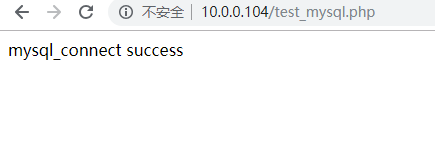
5, Zabbix Server compilation and installation
zabbix's official website: https://www.zabbix.com/
1. Download the installation package, compile and install
yum install -y libevent-devel wget tar gcc gcc-c++ make net-snmp-devel libxml2-devel libcurl-devel cd /usr/local/src/ wget 'https://nchc.dl.sourceforge.net/project/zabbix/ZABBIX%20Latest%20Stable/4.0.3/zabbix-4.0.3.tar.gz' tar -zxvf zabbix-4.0.3.tar.gz cd zabbix-4.0.3 ./configure --prefix=/usr/local/zabbix --enable-server --enable-agent --with-mysql=/usr/local/mysql/bin/mysql_config --with-net-snmp --with-libcurl --with-libxml2 make && make install
Option description
--prefix Specify the installation directory --enable-server install zabbix server --enable-agent install zabbix agent --with-mysql use mysql To store
2. Add zabbix user
useradd -s /sbin/nologin zabbix chown -R zabbix:zabbix /usr/local/zabbix
3. Set the zabbix environment variable and view the version
echo "export PATH=$PATH:/usr/local/zabbix/sbin/:/usr/local/zabbix/bin/" >> /etc/profile source /etc/profile zabbix_server --version

4. mysql database initialization: first create the database and then authorize
mysql -h 127.0.0.1 -uroot -p123456 create database zabbix character set utf8 collate utf8_bin; grant all privileges on zabbix.* to zabbix@'127.0.0.1' identified by '123456'; flush privileges; set names utf8; exit;
5. Import zabbix table in order
You can enter mysql, select zabbix library, and import source in MySQL
mysql -h 127.0.0.1 -uroot -p123456 use zabbix; source /usr/local/src/zabbix-4.0.3/database/mysql/schema.sql; source /usr/local/src/zabbix-4.0.3/database/mysql/images.sql; source /usr/local/src/zabbix-4.0.3/database/mysql/data.sql;
You can also import directly from the outside with shell commands
mysql -uroot -p123456 zabbix < /usr/local/zabbix-4.0.2/database/mysql/schema.sql mysql -uroot -p123456 zabbix < /usr/local/zabbix-4.0.2/database/mysql/images.sql mysql -uroot -p123456 zabbix < /usr/local/zabbix-4.0.2/database/mysql/data.sql
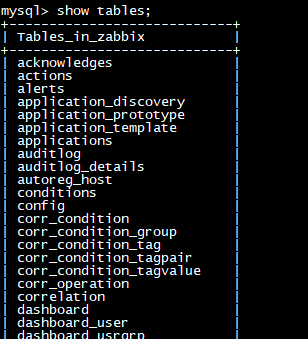
6. For the configuration of zabbix server, you can back up the original and then recreate it, so as to save the need to find the configuration one by one
vim /usr/local/zabbix/etc/zabbix_server.conf
ListenPort=10051 LogFile=/usr/local/zabbix/zabbix_server.log PidFile=/usr/local/zabbix/zabbix_server.pid DBHost=127.0.0.1 DBName=zabbix DBUser=zabbix DBPassword=123456 DBPort=3306 Timeout=30 #Alarm script location AlertScriptsPath=/usr/local/zabbix/alertscripts ExternalScripts=/usr/local/zabbix/externalscripts LogSlowQueries=3000
Then set the user of the directory
chown -R zabbix:zabbix /usr/local/zabbix
7. Zabbix Web installation
mkdir /usr/local/nginx/html/zabbix cp -a /usr/local/src/zabbix-4.0.3/frontends/php/* /usr/local/nginx/html/zabbix/
8. Modify nginx, change the nginx startup user to root to prevent inaccessible resources, and then add index PHP, you can directly access the home page of zabbix without adding index php
server {
listen 80;
server_name 10.191.80.199;
access_log /data/log/nginx/zabbix.access.log main;
index index.html index.php index.html;
root /data/app/nginx/html/;
location /zabbix/{
try_files $uri $uri/ /index.php?$args;
}
location ~ \.php$ {
root html;
fastcgi_pass 127.0.0.1:9000;
fastcgi_index index.php;
fastcgi_param SCRIPT_FILENAME $document_root$fastcgi_script_name;
include fastcgi_params;
}
}
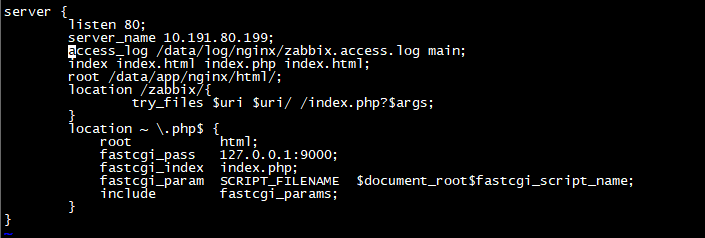
9. zabbix web requires php configuration optimization
vim /usr/local/php/etc/php.ini post_max_size = 32M max_execution_time = 350 max_input_time = 350 date.timezone = Asia/Shanghai always_populate_raw_post_data = -1
Then restart php
systemctl restart php-fpm
Start zabbix_server
zabbix_server
10. Visit the home page and set index PHP, so you can access it directly
http://IP/zabbix
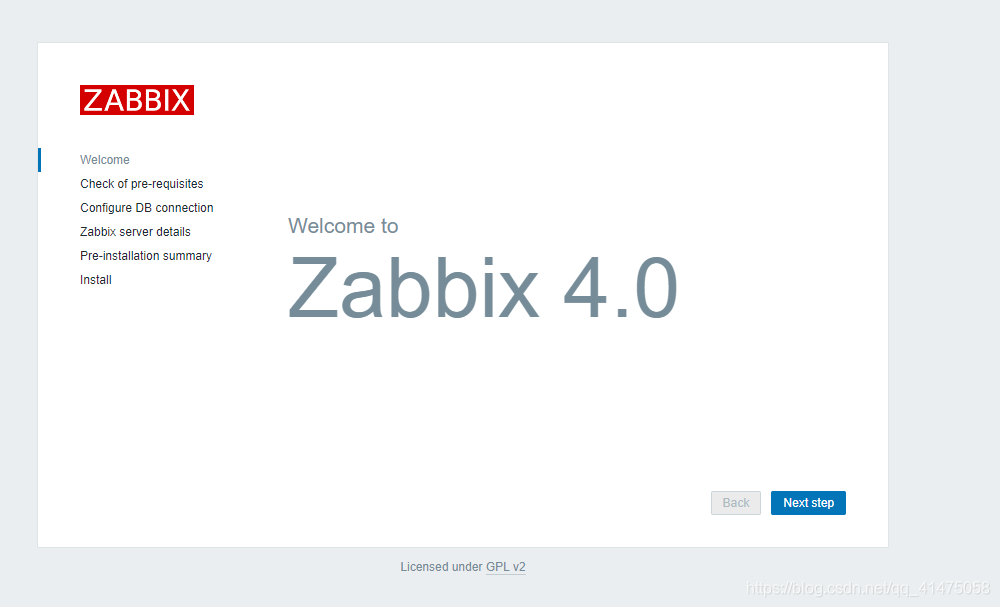
php configuration has been changed and is normal
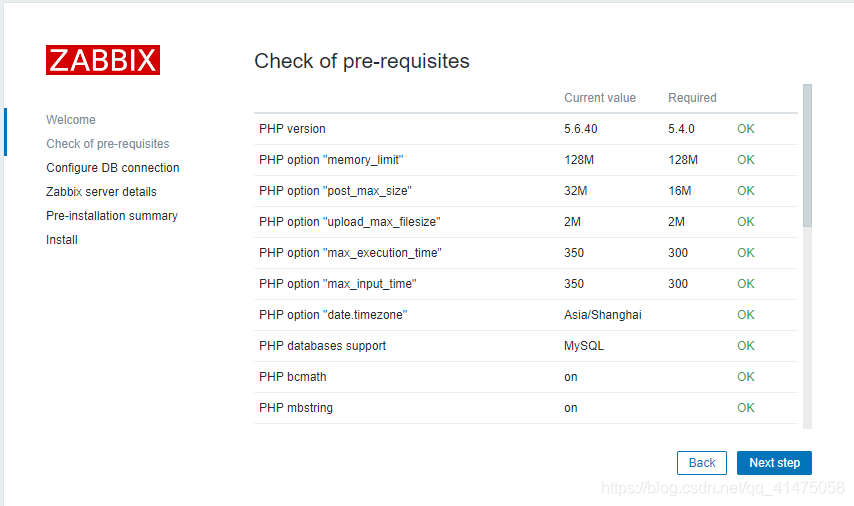
The database configuration is filled in according to the previous settings
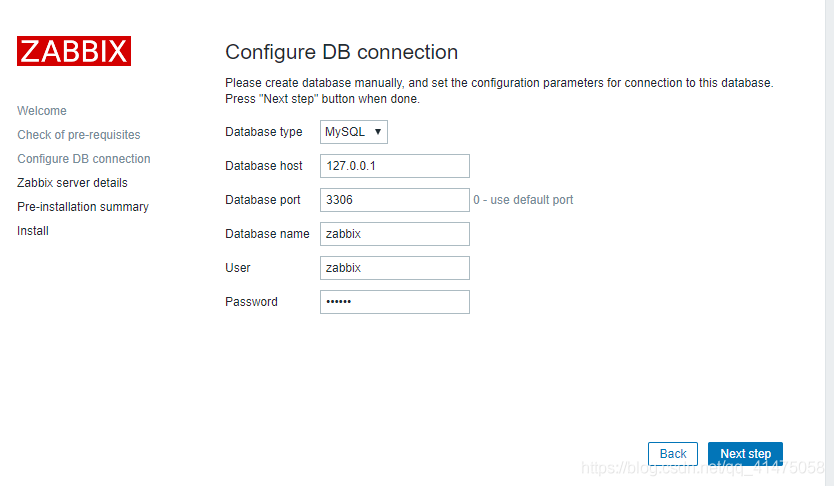
Finally, you may be prompted that the configuration file cannot be created. You need to download it and put it under the prompted folder and set permissions. Otherwise, you may be prompted that you cannot access the configuration.
chmod 644 /usr/local/nginx/html/zabbix/conf/zabbix.conf.php
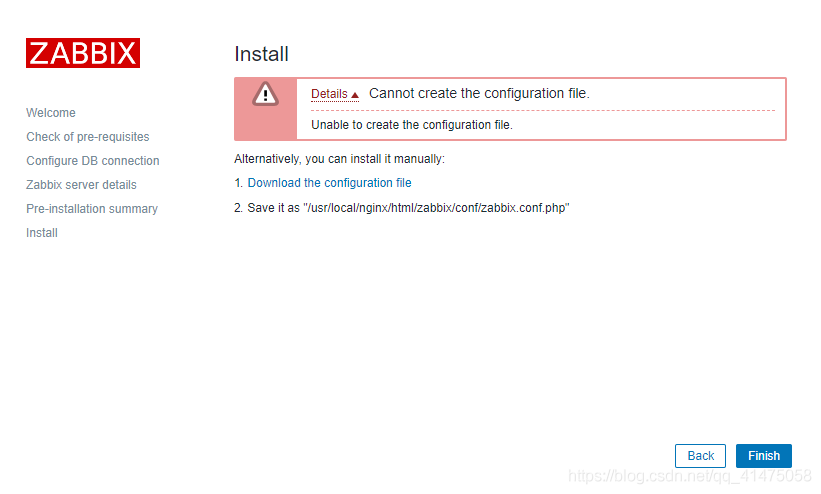
11. Then you can log in. The default user name and password are Admin zabbix
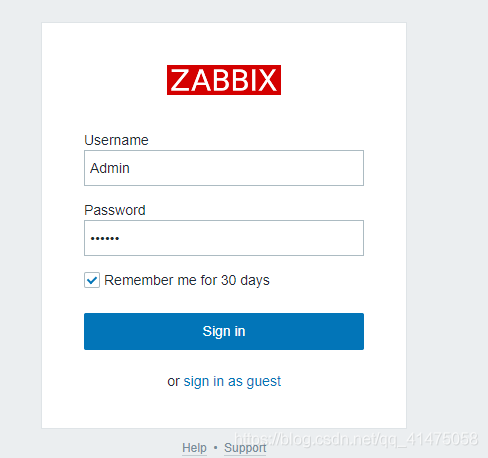
The home page is as follows

Click the user button in the upper left corner to enter, which can be set to Chinese and change the password

Set it to Chinese. You can also set the password in the management - user and create a new user.

6, zabbix solves Chinese garbled code
1. Although it can be set to Chinese in the user's settings, the default Chinese may be garbled
For example, if you select cpu load in (monitoring – graphics), you can see that some contents are garbled
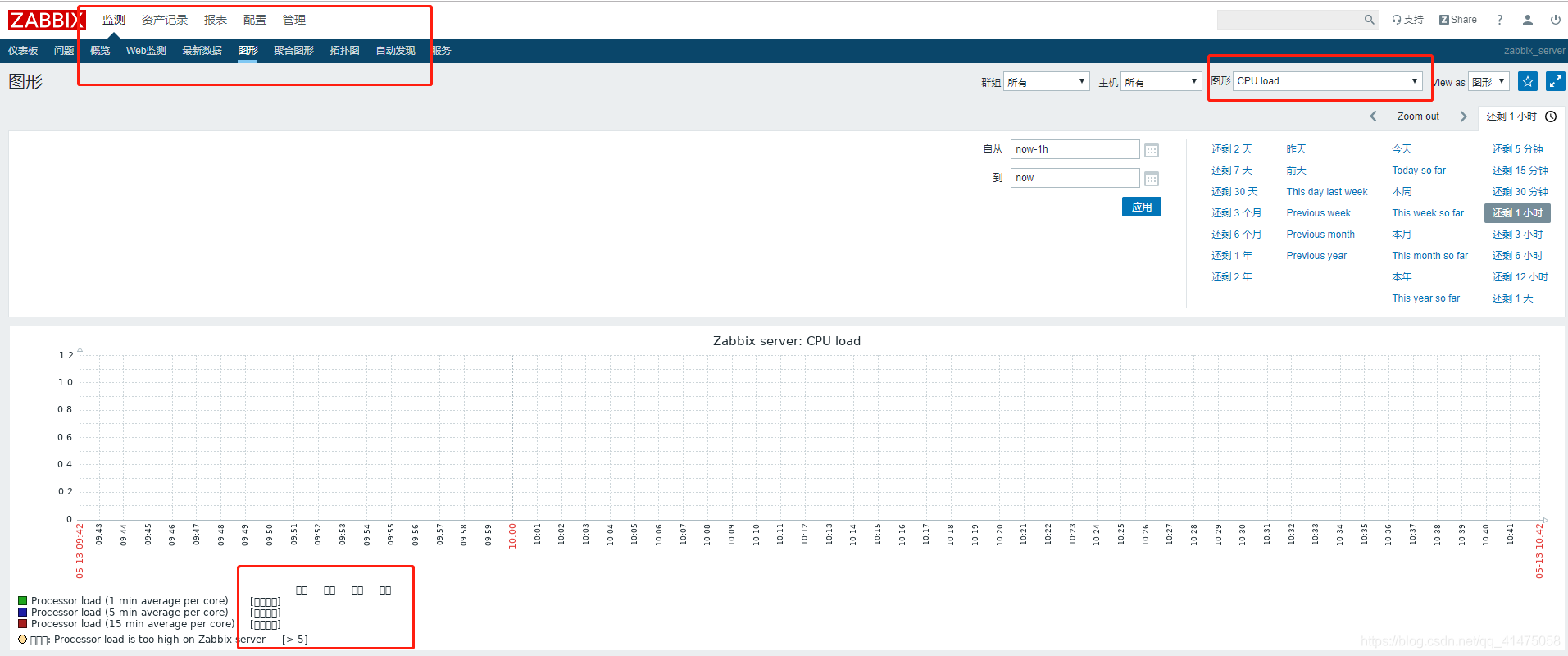
2. The default font file is in the fonts directory of zabbix web directory. The default is DejaVuSans font. This font will be partially garbled in Chinese
[root@localhost ~]# cd /usr/local/nginx/html/zabbix/fonts/ [root@localhost fonts]# ls DejaVuSans.ttf
3. You can find the Microsoft elegant black font in the C:\Windows\Fonts directory of window, and then put it in the fonts directory of zabbix and change it to msyh TTF, you can also download one online, and then set the permission to 644, so that zabbix can read the font file
[root@localhost fonts]# chmod 644 msyh.ttf [root@localhost fonts]# ls DejaVuSans.ttf msyh.ttf
4. Change DejaVuSans in the configuration file to msyh. There are two places to change.
vim /usr/local/nginx/html/zabbix/include/defines.inc.php
5. Then refresh the next page and you can see that the Chinese is normal
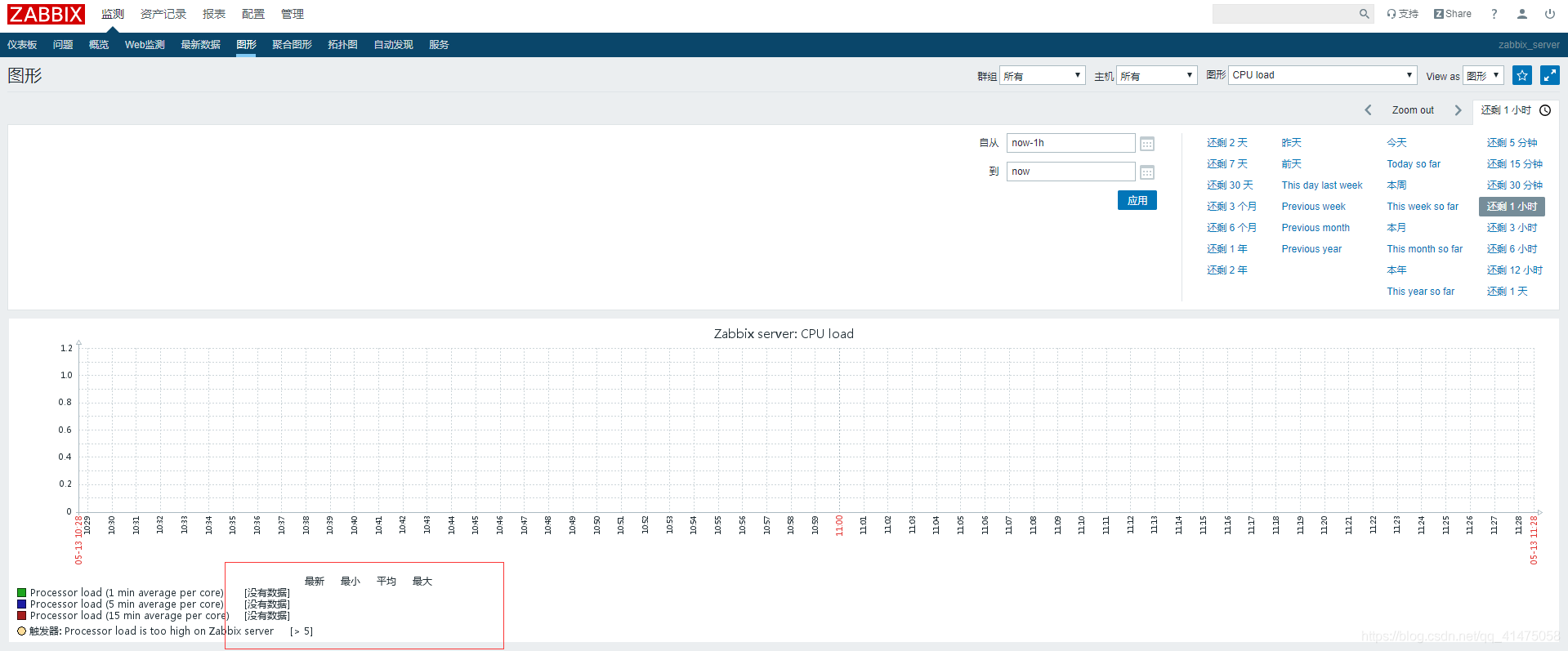
Installation package and Chinese font network disk address
Link: https://pan.baidu.com/s/1D6YDRY3xGCc66hP28M79rg
Extraction code: 7p3n
reference material: https://blog.csdn.net/qq_41475058/article/details/106056778